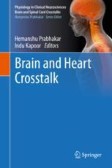Search
Search Results
-
Oxygen Metabolism-induced Stress Response Underlies Heart–brain Interaction Governing Human Consciousness-breaking and Attention
Neuroscientists have emphasized visceral influences on consciousness and attention, but the potential neurophysiological pathways remain under...

-
The Meridian–Viscera Correlationship: Theory and Mechanisms of Heart Meridian–Heart–Brain Interactions
Meridians and collaterals are considered to be objective entities in the human body. Meridian theory is a foundational component of traditional...
-
Associations of resting heart rate with incident dementia, cognition, and brain structure: a prospective cohort study of UK biobank
BackgroundResting heart rate (RHR) has been linked with an increased risk of dementia. However, evidence characterizing the associations of RHR with...

-
Cerebral derailment after myocardial infarct: mechanisms and effects of the signaling from the ischemic heart to brain
Myocardial infarction (MI) is the leading cause of death among ischemic heart diseases and is associated with several long-term cardiovascular...

-
Identification of a novel compound heterozygous SMG9 variants in a Chinese family with heart and brain malformation syndrome using whole exome sequencing
SMG9-deficiency syndrome, also known as heart and brain malformation syndrome, is a very rare congenital genetic disorder mainly characterized by...

-
Brain volumes in adults with congenital heart disease correlate with executive function abilities
Congenital heart disease is the most common birth defect, and patients are at risk for neurodevelopmental impairment and brain abnormalities. Yet,...

-
Genetic drivers of m6A methylation in human brain, lung, heart and muscle
The most prevalent post-transcriptional mRNA modification, N 6 -methyladenosine (m 6 A), plays diverse RNA-regulatory roles, but its genetic control in...

-
Plasma proteome of Long-COVID patients indicates HIF-mediated vasculo-proliferative disease with impact on brain and heart function
AimsLong-COVID occurs after SARS-CoV-2 infection and results in diverse, prolonged symptoms. The present study aimed to unveil potential mechanisms,...

-
Brain and Heart Crosstalk
This book discusses the underlying mechanisms connecting the brain and heart. The physiology of the brain is such that it is easily affected by any...

-
The Brain–Heart Crosstalk
Acute neurocardiogenic injury is a relevant complication occurring after an acute brain injury, especially after subarachnoid haemorrhage, and is...
-
Docosahexaenoic Acid (DHA) Supplementation Alters Phospholipid Species and Lipid Peroxidation Products in Adult Mouse Brain, Heart, and Plasma
The abundance of docosahexaenoic acid (DHA) in phospholipids in the brain and retina has generated interest to search for its role in mediating...

-
Interaction between childhood trauma experience and TPH2 rs7305115 gene polymorphism in brain gray matter volume
BackgroundChildhood trauma is one of the most extensively studied and well-supported environmental risk factors for the development of mental health...

-
Pharmacological interaction and immune response of purinergic receptors in therapeutic modulation
Nucleosides and purine nucleotides serve as transmitter and modulator agents that extend their functions beyond the cell. In this context, purinergic...

-
The interaction of breath holding and muscle mechanoreflex on cardiovascular responses in breath-hold divers and non-breath-hold divers
Cardiovascular responses to diving are characterized by two opposing responses: tachycardia resulting from exercise and bradycardia resulting from...

-
Nutrients/Nutrition and Drug Interaction
Drug-nutrient interactions are the reactions between drugs and nutrients, which are involved in the chemical, physical, physiological, or...
-
Identifying the Interaction Between Tuberculosis and SARS-CoV-2 Infections via Bioinformatics Analysis and Machine Learning
The number of patients with COVID-19 caused by severe acute respiratory syndrome coronavirus 2 is still increasing. In the case of COVID-19 and...

-
Mood and behavior regulation: interaction of lithium and dopaminergic system
Lithium is one of the most effect mood-stabilizing drugs prescribed especially for bipolar disorder. Lithium has wide range effects on different...

-
Pathogen–Host Interaction and Its Associated Molecular Mechanism in HFMD Pathology and Immunology
Hand, foot, and mouth disease (HFMD) is caused by the enterovirus family, which includes EV-A71 and more than 10 other members. The disease involves...
-
COVID-19 drugs: potential interaction with ATP-binding cassette transporters P-glycoprotein and breast cancer resistance protein
BackgroundThe coronavirus disease 2019 (COVID-19) pandemic, caused by severe acute respiratory syndrome coronavirus 2, has resulted in acute...

-
Tacrolimus Drug–Drug Interaction with Nirmatrelvir/Ritonavir (Paxlovid™) Managed with Phenytoin
IntroductionThe novel severe acute respiratory syndrome coronavirus 2 (SARS-CoV-2 or COVID-19) pandemic has had a significant impact on communities...

